Evaluating MIMO-VLC System Performance: Modulation Techniques and Ambient Light Interference Effects
Abstract
1. Introduction
2. Related Work
- Performance Evaluation of MIMO–VLC: The paper evaluates the performance of a MIMO–VLC system under various modulation techniques, specifically NRZ, RZ, and QPSK.
- Comparison of modulation schemes for ambient light interference mitigation: The paper compares the effectiveness of different modulation schemes (NRZ, RZ, and QPSK) in mitigating ambient light interference and optimizing performance.
- Resilience to Ambient Light Interference: The study investigates how MIMO-–LC systems perform in the presence of ambient light interference, focusing on the system’s robustness.
- Distance and Transmission Capability: It analyzes the system’s ability to transmit over different distances and assesses the performance in terms of distance coverage.
3. VLC System Model
3.1. MIMO VLC Channel Model
3.2. Ambient Light Noise Model
3.3. Modulation Characteristics and BER Performance
- NRZ: Its superior performance, particularly under ambient light interference, can be attributed to its lower spectral width and better energy efficiency, which reduce vulnerability to noise. The BER expression of NRZ is written as [16]:where Pr is the received optical power, N0 is the noise power spectral density and Q(.) is the Q-function and given as:
- RZ: While RZ modulation offers better timing accuracy, its higher bandwidth requirement and shorter pulse duration make it more susceptible to interference and attenuation, explaining its relatively lower performance. Its BER is expressed as [16]:
- QPSK: The robust phase-based modulation of QPSK provides enhanced resilience to noise and interference, which is why it performs well under challenging conditions. For QPSK, the BER is [27]:where N is the number of spatial streams in MIMO systems. The SNR in a MIMO system is calculated as:where Pt is the transmitted power vector. According to the above expressions, the BER in VLC systems depends on the received SNR, channel conditions, and the modulation scheme.
4. Implementation of MIMO–VLC Using OptiSystem
4.1. Without Ambient Light
4.2. With Ambient Light
5. Simulation Results and Discussions
5.1. Performance Analysis
5.2. Results Without Ambient Light Noise
5.3. Results with Ambient Light Noise
5.4. Performance Comparison
5.5. Effects of Different Ambient Light Sources
6. Conclusions
Author Contributions
Funding
Institutional Review Board Statement
Informed Consent Statement
Data Availability Statement
Acknowledgments
Conflicts of Interest
Abbreviations
| VLC | Visible light communication |
| MIMO | Multiple-input, multiple-output |
| SISO | Single input, single output |
| NRZ | Non-return to zero |
| RZ | Return to zero |
| QPSK | Quadrature phase shift keying |
| OOK | On-off keying |
| LEDs | Light-emitting diodes |
| LASER | Light amplification by stimulated emission radiation |
| Li-Fi | light-fidelity |
| ITS | Intelligent transportation systems |
| FPGA | Field programmable gate arrays |
| V2V | vehicle-to-vehicle |
| I2V | infrastructure-to-vehicle |
References
- Sarbazi, E.; Kazemi, H.; Crisp, M.; El-Gorashi, T.; Elmirghani, J.; Richard, V.; Penty, R.V.; White, I.H.; Safari, M.; Haas, H. Design and Optimization of High-Speed Receivers for 6G Optical Wireless Networks. IEEE Trans. Commun. 2024, 72, 971–990. [Google Scholar] [CrossRef]
- Sejan, M.A.S.; Rahman, M.H.; Aziz, M.A.; Kim, D.-S.; You, Y.-H.; Song, H.-K. A Comprehensive Survey on MIMO Visible Light Communication: Current Research, Machine Learning and Future Trends. Sensors 2023, 23, 739. [Google Scholar] [CrossRef] [PubMed]
- Hassan, E.S. Three layer hybrid PAPR reduction method for NOMA-based FBMC-VLC networks. Opt. Quant. Electron. 2024, 56, 890. [Google Scholar] [CrossRef]
- Alrakah, H.T.; Gutema, T.Z.; Sinanovic, S.; Popoola, W.O. PAPR Reduction in PAM-DMT based WDM VLC. In Proceedings of the 2022 13th International Symposium on Communication Systems, Networks and Digital Signal Processing (CSNDSP), Porto, Portugal, 20–22 July 2022; pp. 174–178. [Google Scholar] [CrossRef]
- Alrakah, H.; Gutema, T.; Offiong, F.; Popoola, W. PAPR Reduction in DCO-OFDM and PAM-DMT Based VLC Systems. In Proceedings of the 2022 Conference on Lasers and Electro-Optics (CLEO), San Jose, CA, USA, 15–20 May 2022; pp. 1–2. [Google Scholar]
- Farid, S.M.; Saleh, M.Z.; Elbadawy, H.M.; Elramly, S.H. ASCO-OFDM based VLC system throughput improvement using PAPR precoding reduction techniques. Opt. Quant. Electron. 2023, 55, 410. [Google Scholar] [CrossRef]
- Zhou, H.; Zhang, M.; Ren, X. Design and Implementation of Wireless Optical Access System for VLC-IoT Networks. J. Light. Technol. 2023, 41, 2369–2380. [Google Scholar] [CrossRef]
- Shaaban, K.; Shamim, M.h.M.; Abdur-Rouf, K. Visible light communication for intelligent transportation systems: A review of the latest technologies. J. Traffic Transp. Eng. 2021, 8, 483–492. [Google Scholar] [CrossRef]
- Kumar, P.; Ali, K.B. Intelligent Traffic System using Vehicle to Vehicle (V2V) & Vehicle to Infrastructure (V2I) communication based on Wireless Access in Vehicular Environments (WAVE) Std. In Proceedings of the 2022 10th International Conference on Reliability, Infocom Technologies and Optimization (Trends and Future Directions) (ICRITO), Noida, India, 13–14 October 2022; pp. 1–5. [Google Scholar] [CrossRef]
- Pramudya, T.; Yudistira, R.P.; Trisnawan, M.A.; Setianingrum, L.; Wijayanto, Y.N.; Hamidah, M.; Dewi, M.F.; Firdaus, M.Y.; Rasuanta, M.P.; Rahmadiansyah, M.; et al. Transmitter and Receiver Design for Visible Light Communication System with Off-the-Shelf LED Towards its Implementation Possibility for Vehicle to Vehicle/Infrastructure (V2V/V2I) Communication. In Proceedings of the 2023 International Conference on Radar, Antenna, Microwave, Electronics, and Telecommunications (ICRAMET), Bandung, Indonesia, 15–16 November 2023; pp. 258–263. [Google Scholar] [CrossRef]
- Georlette, V.; Moeyaert, V.; Bette, S.; Point, N. Visible Light Communication Challenges in the Frame of Smart Cities. In Proceedings of the 2020 22nd International Conference on Transparent Optical Networks (ICTON), Bari, Italy, 19–23 July 2020; pp. 1–4. [Google Scholar] [CrossRef]
- Eldeeb, H.B.; Uysal, M. Visible Light Communication-Based Outdoor Broadcasting. In Proceedings of the 2021 17th International Symposium on Wireless Communication Systems (ISWCS), Berlin, Germany, 6–9 September 2021; pp. 1–6. [Google Scholar] [CrossRef]
- Sonmez, M.; Sökmen, Ö.G. Ambient Light Effect on Receiver for Visible Light Communication Systems. Gazi Univ. J. Sci. 2022, 35, 1393–1403. [Google Scholar] [CrossRef]
- Alsalami, F.M.; Haas, O.C.L.; Al-Kinani, A.; Wang, C.-X.; Ahmad, Z.; Rajbhandari, S. Impact of Dynamic Traffic on Vehicle-to-Vehicle Visible Light Communication Systems. IEEE Syst. J. 2022, 16, 3512–3521. [Google Scholar] [CrossRef]
- Won, Y.-Y.; Yoon, S.M.; Seo, D. Ambient LED light noise reduction using adaptive differential equalization in Li-Fi wireless link. Sensors 2021, 21, 1060. [Google Scholar] [CrossRef]
- Ibrahim, H.S.; Abaza, M.; Mansour, A.; Alfalou, A. Performance Analysis of Power Allocation and User-Pairing Techniques for MIMO-NOMA in VLC Systems. Photonics 2024, 11, 206. [Google Scholar] [CrossRef]
- Faheem, M.; Verma, I.K.; Nag, P.; Goswami, S.; Singh, V. Performance Analysis of Indoor Visible Light Communication System Using NRZ-OOK Modulation Technique. In Advances in Smart Communication and Imaging Systems; Lecture Notes in Electrical Engineering; Agrawal, R., Kishore Singh, C., Goyal, A., Eds.; Springer: Singapore, 2021; Volume 721. [Google Scholar] [CrossRef]
- Chen, C.; Huang, S.; Tavakkolnia, I.; Safari, M.; Haas, H. Spatial and Wavelength Division Joint Multiplexing System Design for MIMO-OFDM Visible Light Communications. IEEE Access 2024, 12, 109526–109543. [Google Scholar] [CrossRef]
- Guo, J.-N.; Zhang, J. Spatial Constellation Design for MIMO Visible Light Communication Based on the Optimal Geometric Shaping. IEEE Photonics J. 2024, 16, 1–10. [Google Scholar] [CrossRef]
- Hassan, E.S. Multi-Carrier Communication Systems with Examples in MATLAB®: A New Perspective; Taylor & Francis: Oxfordshire, UK; CRC Press: Boca Raton, FL, USA, 2015; ISBN 9781498735322. [Google Scholar]
- Hassan, E.S. Performance Enhancement and PAPR Reduction for MIMO based QAM-FBMC Systems. PLoS ONE 2024, 19, e0296999. [Google Scholar] [CrossRef]
- Hassan, S.; Panayırcı, E. Physical Layer Security with MIMO-Generalized Space Shift Keying Modulation Technique in Li-Fi Systems. In Proceedings of the 2024 32nd Signal Processing and Communications Applications Conference (SIU), Mersin, Turkiye, 15–18 May 2024; pp. 1–4. [Google Scholar] [CrossRef]
- Zhou, H.; Zhang, M.; Wang, X.; Ren, X. Design and Implementation of More Than 50m Real-Time Underwater Wireless Optical Communication System. J. Light. Technol. 2022, 40, 3654–3668. [Google Scholar] [CrossRef]
- Nguyen, H.; Jang, Y.M. Design of MIMO C-OOK using Matched filter for Optical Camera Communication System. In Proceedings of the 2021 International Conference on Artificial Intelligence in Information and Communication (ICAIIC), Jeju Island, Republic of Korea, 13–16 April 2021; pp. 474–476. [Google Scholar] [CrossRef]
- Ganjian, T.; Baghersalimi, G.; Ghassemlooy, Z. Performance Evaluation of a MIMO VLC System Employing Single Carrier Modulation with Frequency Domain Equalization. In Proceedings of the 2020 3rd West Asian Symposium on Optical and Millimeter-Wave Wireless Communication (WASOWC), Tehran, Iran, 24–25 November 2020; pp. 1–5. [Google Scholar] [CrossRef]
- Yeh, C.-H.; Weng, J.-H.; Chow, C.-W.; Luo, C.-M.; Xie, Y.-R.; Chen, C.-J.; Wu, M.-C. 1.7 to 2.3 Gbps OOK LED VLC Transmission Based on 4 × 4 Color-Polarization-Multiplexing at Extremely Low Illumination. IEEE Photonics J. 2019, 11, 1–6. [Google Scholar] [CrossRef]
- Shivam, C.; Sharma, S.; Singh, S.; Kumar, R. Performance Analysis of an Indoor Visible Light Communication System Using Optisystem Software. In Proceedings of the 2023 Third International Conference on Advances in Electrical, Computing, Communication and Sustainable Technologies (ICAECT), Bhilai, India, 5–6 January 2023; pp. 1–6. [Google Scholar] [CrossRef]
- Ahmed, M.; Atta, M.A.; Farmer, J.; Dawy, Z.; O’Brien, D.; Bermak, A. Multidomain Suppression of Ambient Light in Visible Light Communication Transceivers. IEEE Trans. Intell. Transp. Syst. 2022, 23, 18145–18154. [Google Scholar] [CrossRef]
- Garai, M.; Sliti, M.; Boudriga, N. Access and resource reservation in vehicular Visible Light Communication networks. In Proceedings of the 2016 18th International Conference on Transparent Optical Networks (ICTON), Trento, Italy, 10–14 July 2016; pp. 1–6. [Google Scholar] [CrossRef]
- Krichene, D.; Sliti, M.; Abdallah, W.; Boudriga, N. An aeronautical visible light communication system to enable in-flight connectivity. In Proceedings of the 2015 17th International Conference on Transparent Optical Networks (ICTON), Budapest, Hungary, 5–9 July 2015; pp. 1–6. [Google Scholar] [CrossRef]
- Han, D.; Lee, K. Ambient light noise filtering technique for multimedia high speed transmission system in MIMO-VLC. Multimed. Tools Appl. 2021, 80, 34751–34765. [Google Scholar] [CrossRef]
- Jesuthasan, F.H.; Rohitkumar, H.; Shah, P.; Trestian, R. Implementation and Performance Evaluation of a MIMO-VLC System for Data Transmissions. In Proceedings of the 2019 IEEE International Symposium on Broadband Multimedia Systems and Broadcasting (BMSB), Jeju, Republic of Korea, 5–7 June 2019; pp. 1–6. [Google Scholar]
- Chen, Y.; Zhou, X.; Wang, J.; Dong, Z.; Chen, Y. On Weighted Sum Rate of Multi-User Photon-Counting Multiple-Input Multiple-Output Visible Light Communication Systems under Poisson Shot Noise. Appl. Sci. 2024, 14, 1423. [Google Scholar] [CrossRef]
- Chen, C.; Das, S.; Videv, S.; Sparks, A.; Babadi, S.; Krishnamoorthy, A.; Lee, C.; Grieder, D.; Hartnett, K.; Rudy, P. 100 Gbps Indoor Access and 4.8 Gbps Outdoor Point-to-Point LiFi Transmission Systems Using Laser-Based Light Sources. J. Light. Technol. 2024, 42, 4146–4157. [Google Scholar] [CrossRef]
- Hou, Y.; Wang, Z.; Li, Z.; Hu, J.; Ma, C.; Wang, X.; Xia, L.; Liu, G.; Shi, J.; Li, Z.; et al. Laser-Based Mobile Visible Light Communication System. Sensors 2024, 24, 3086. [Google Scholar] [CrossRef]
- Lu, Z.; Cai, J.; Xu, Z.; Zhou, Y.; Zhang, J.; Shen, C.; Chi, N. 11.2 Gbps 100-meter free-space visible light laser communication utilizing bidirectional reservoir computing equalizer. Opt. Express 2023, 31, 44315–44327. [Google Scholar] [CrossRef] [PubMed]
- Zhou, H.; Zhu, X.; Liu, W.; Jia, J.; Wang, Y.; Zhang, H.; Wang, S.; Yang, A.; Zhang, M. Robust Wide-Angle Optical Wireless Communication System: From Design to Prototype. J. Light. Technol. 2025, 43, 3709–3722. [Google Scholar] [CrossRef]

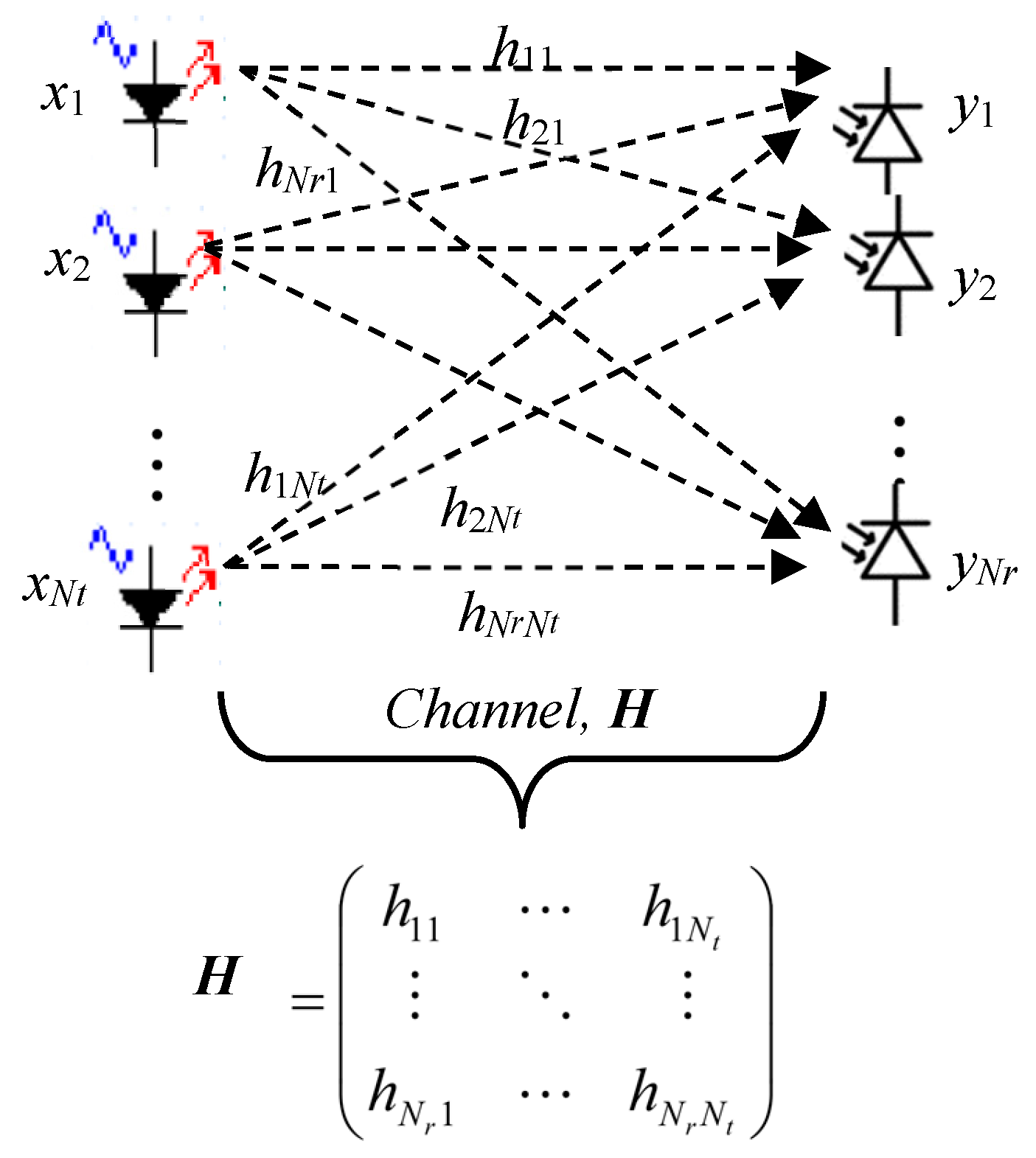



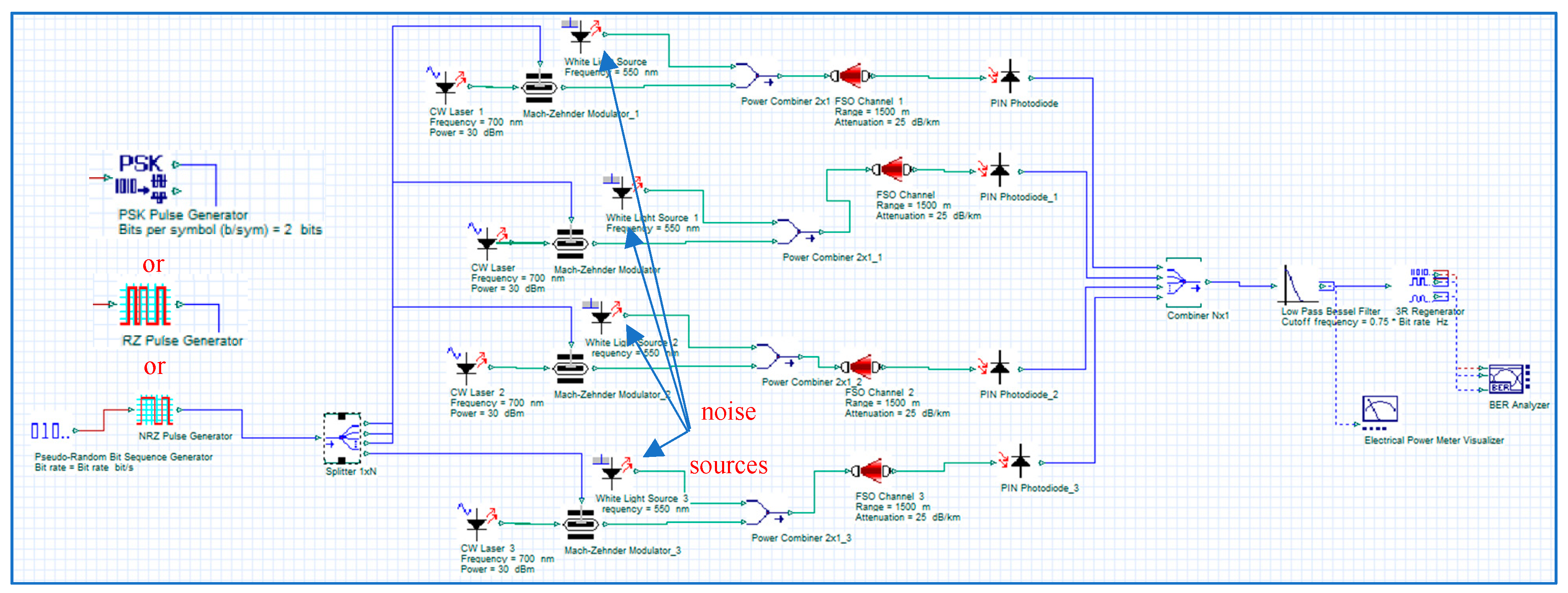
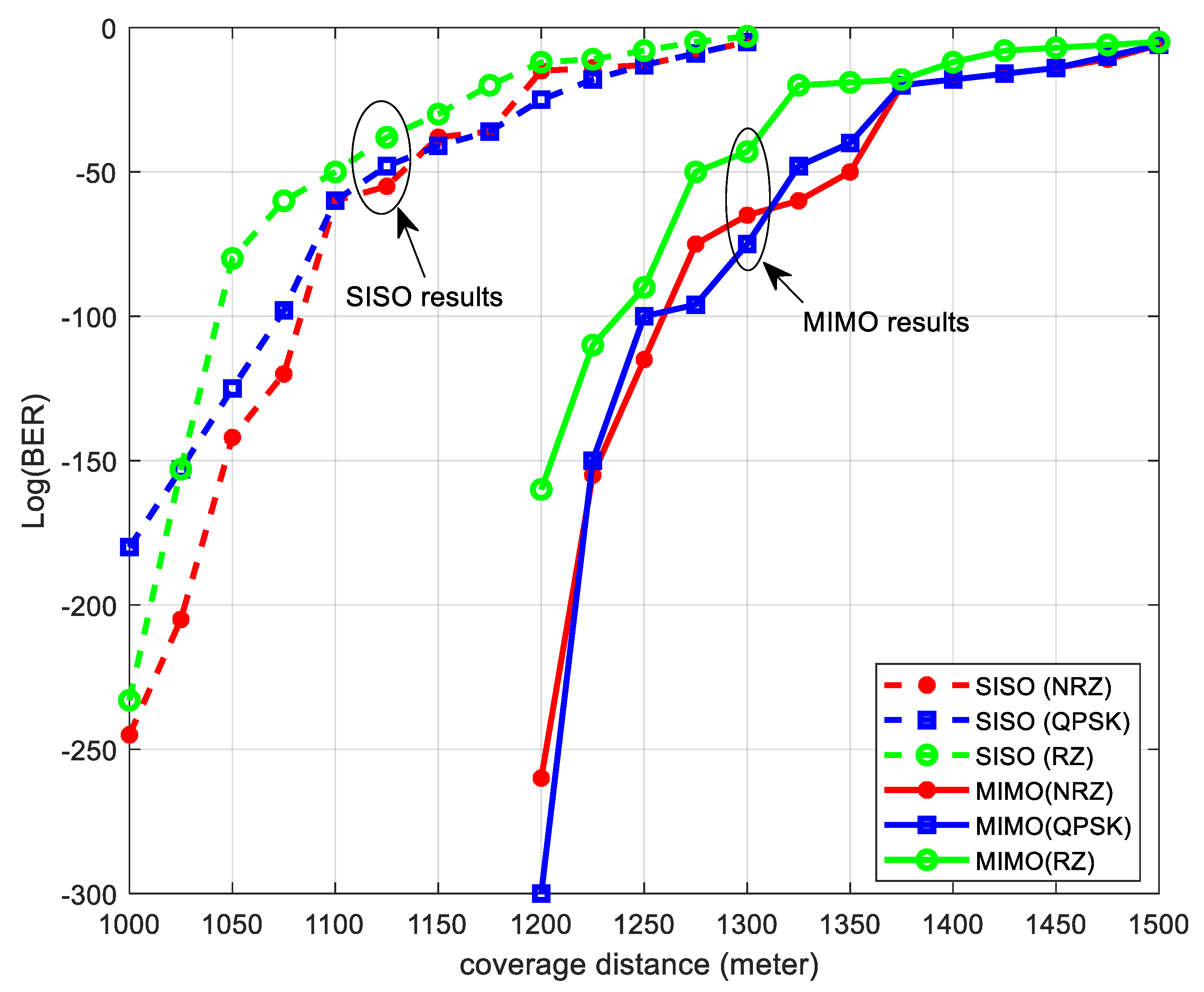

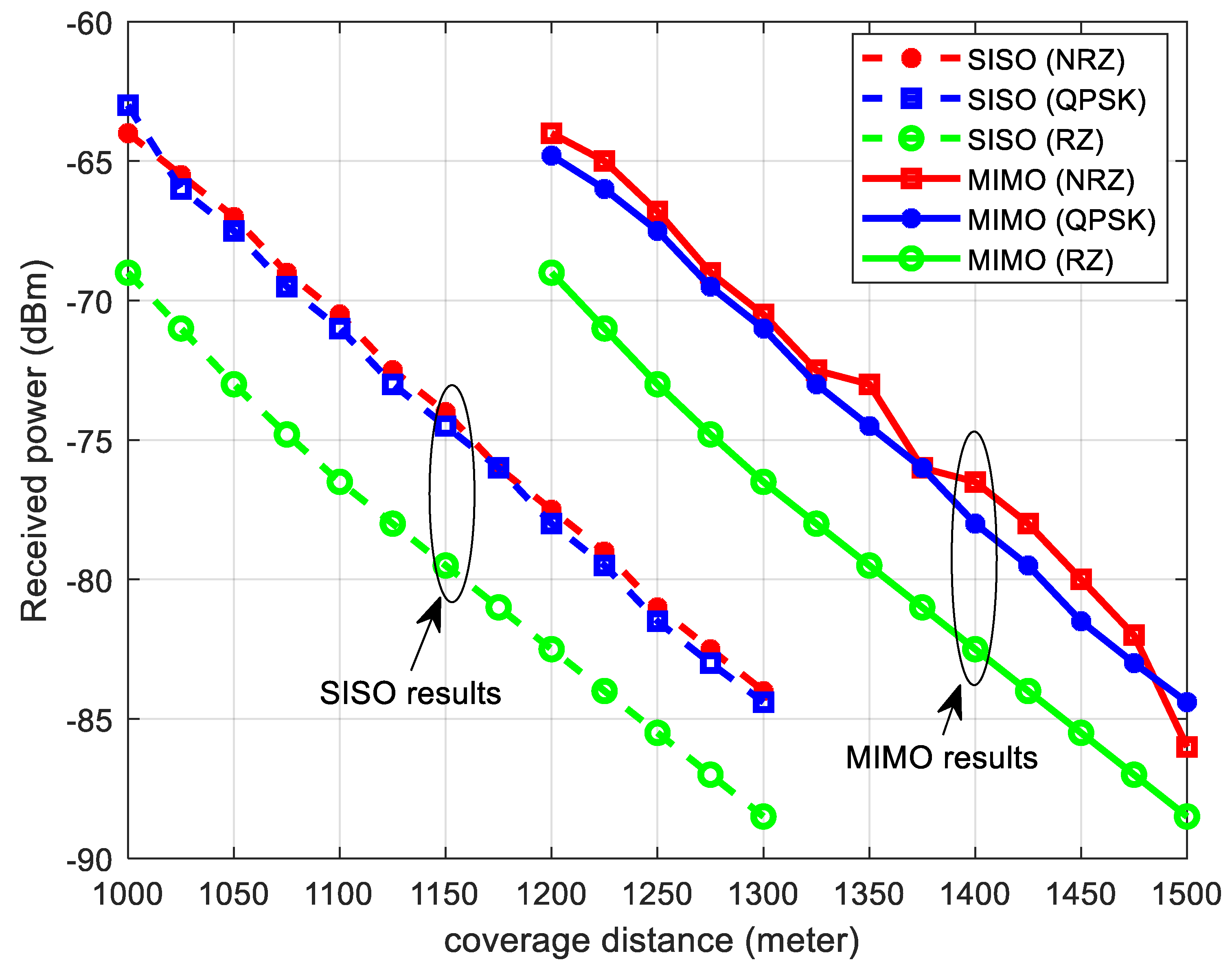
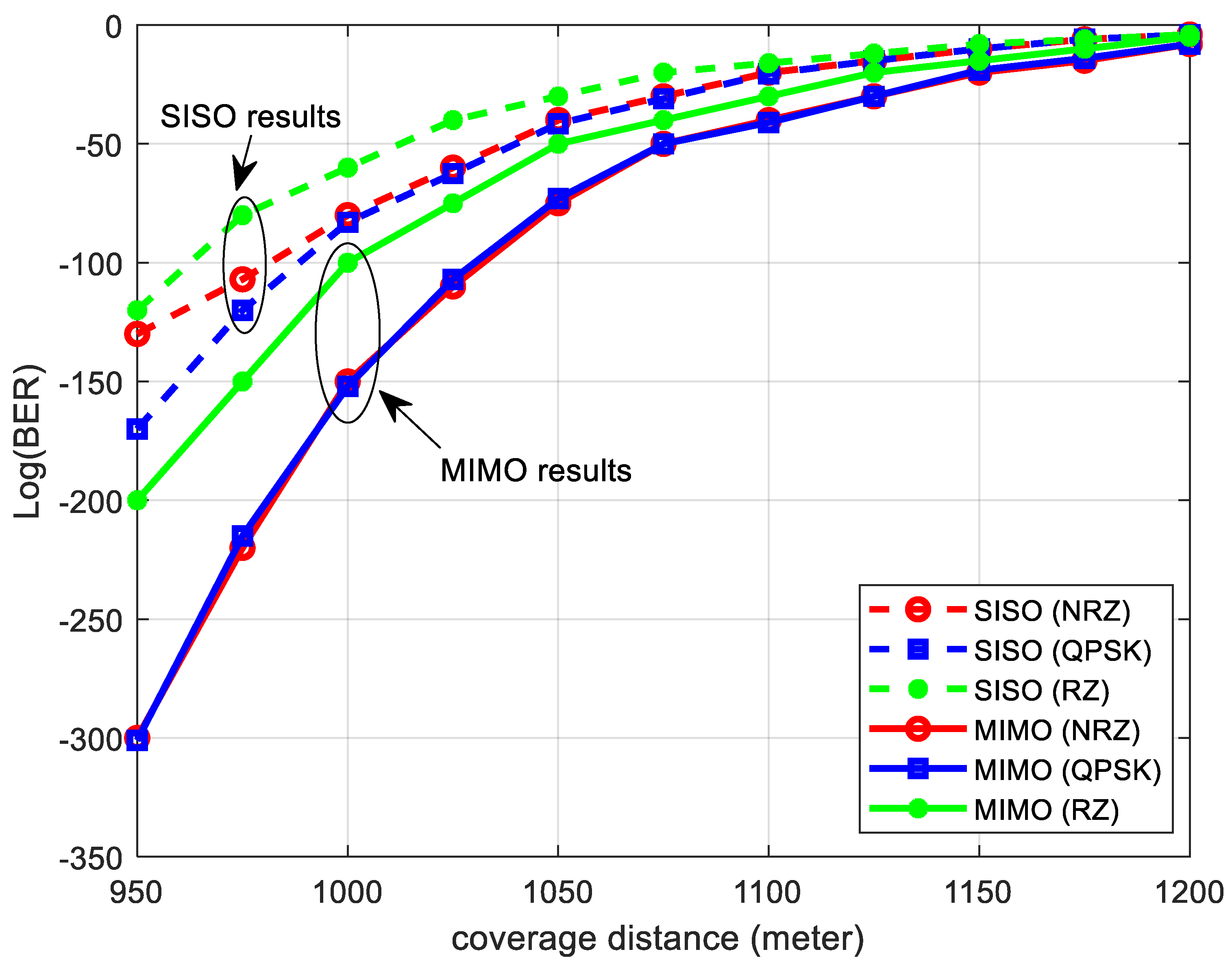
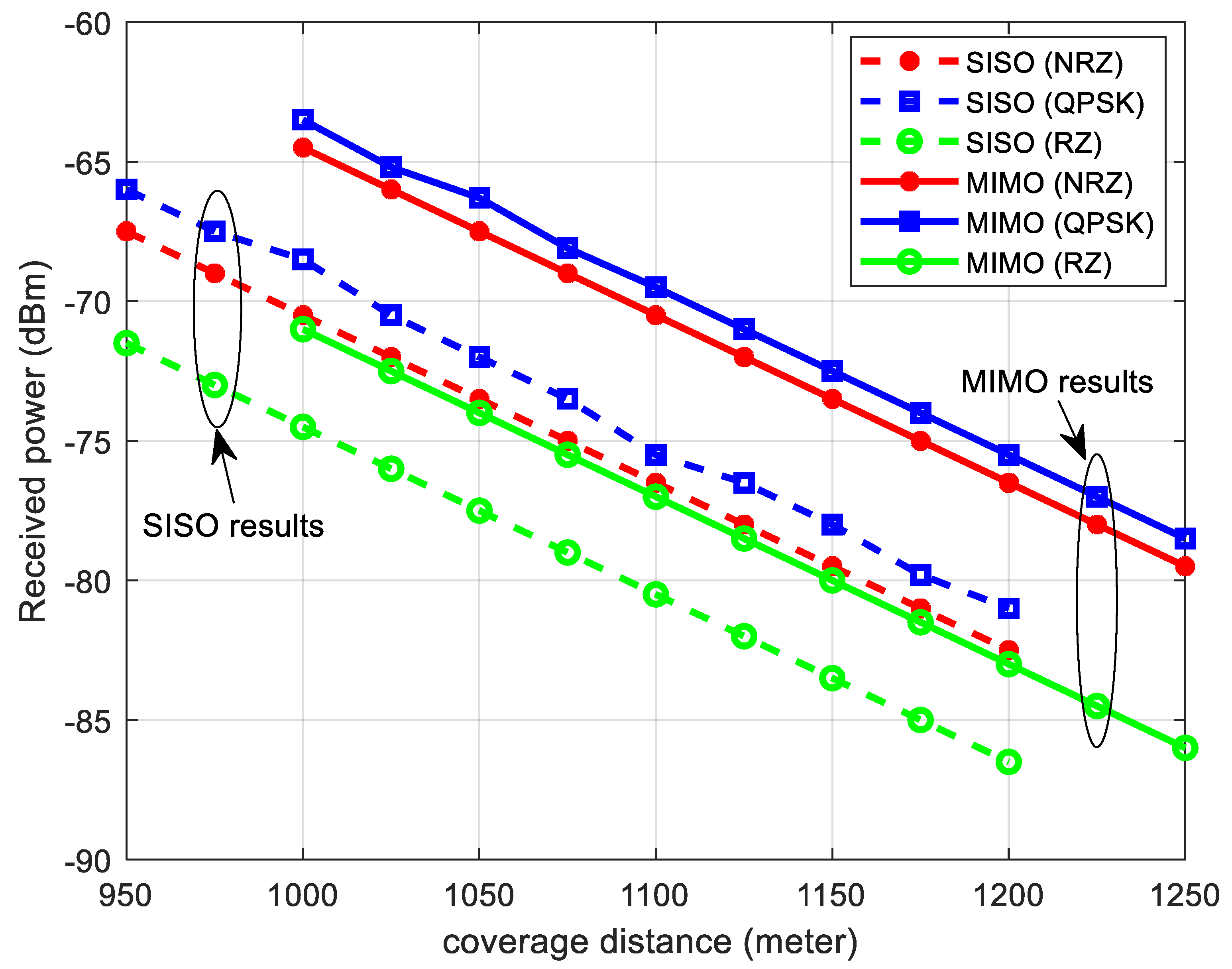
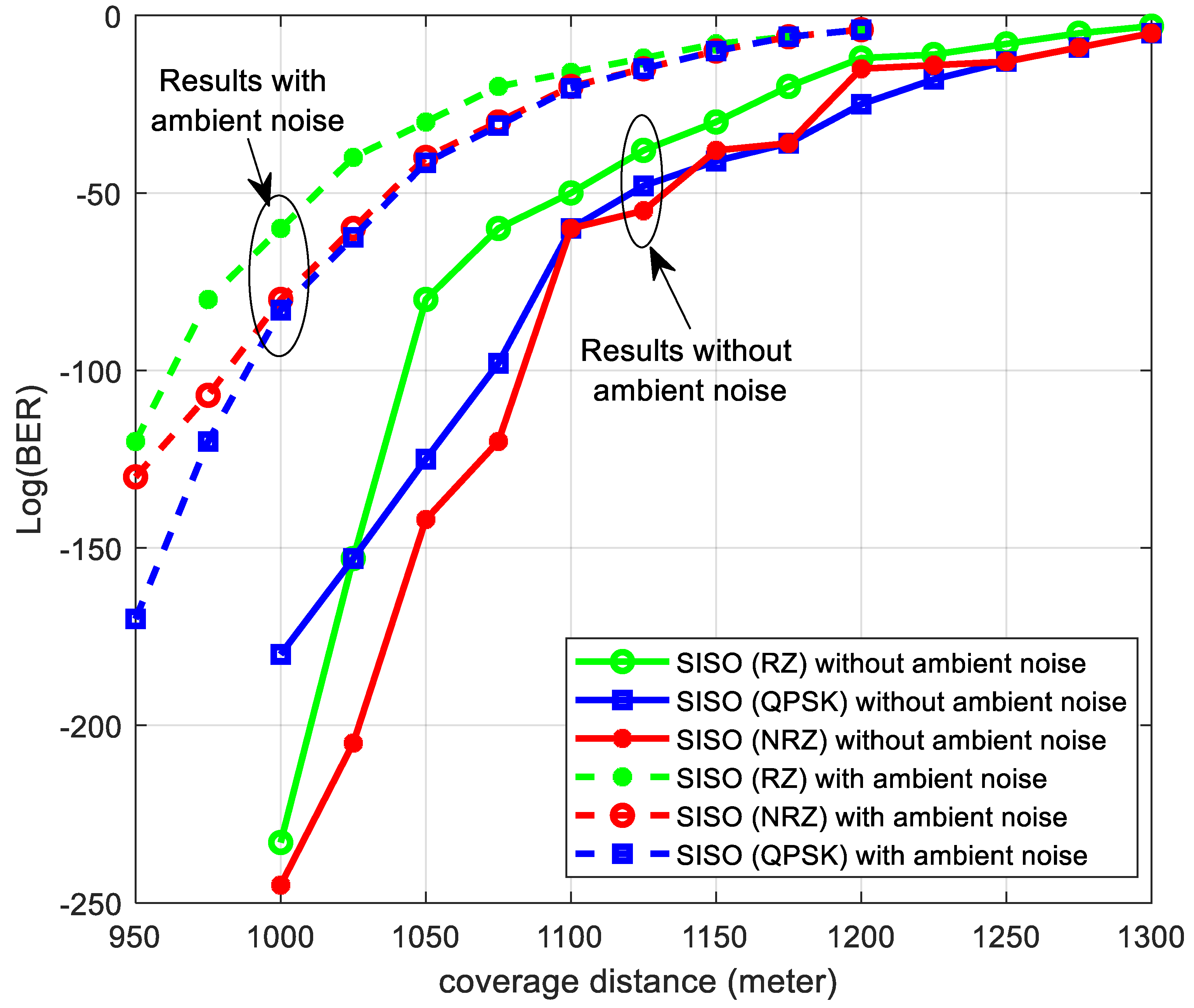
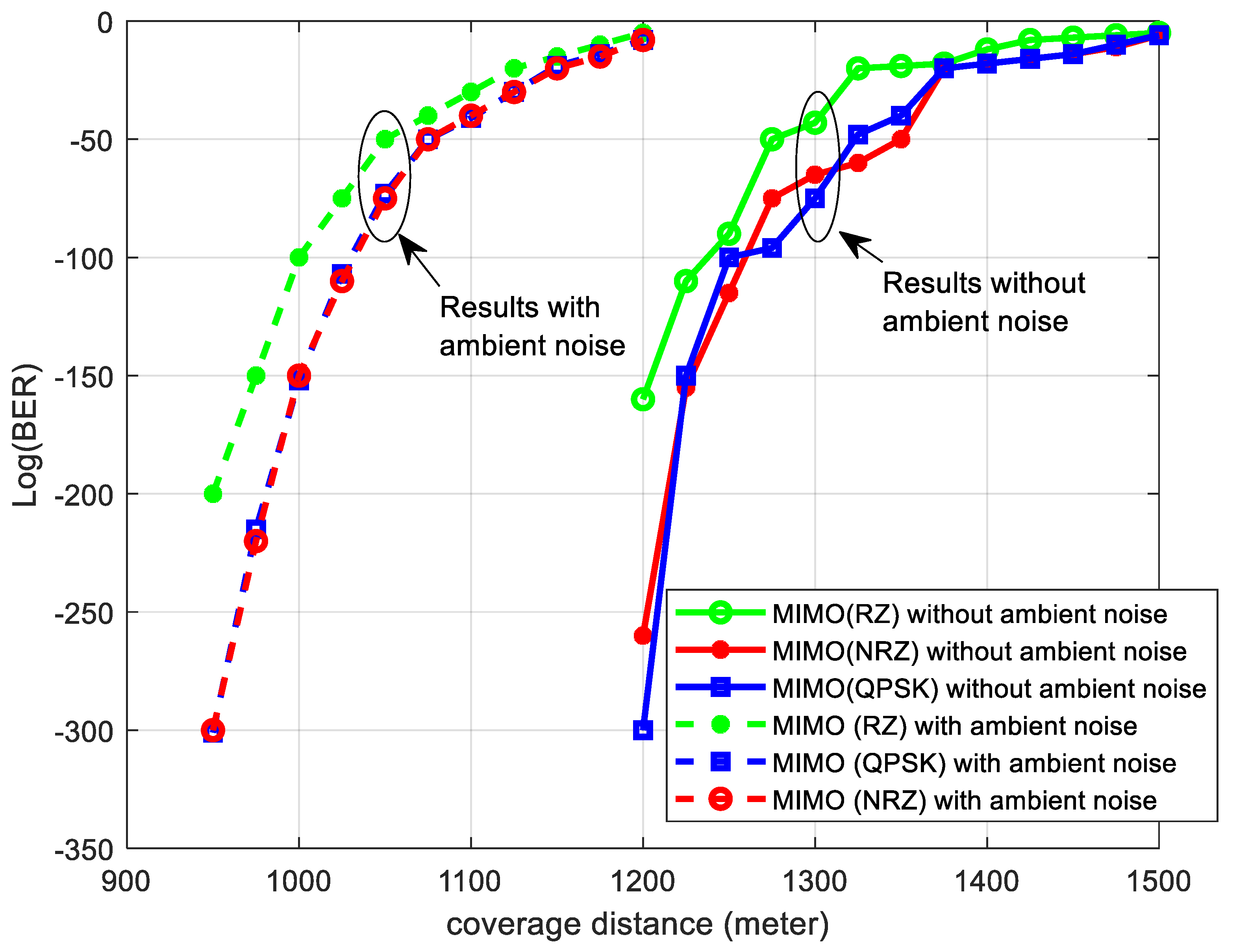
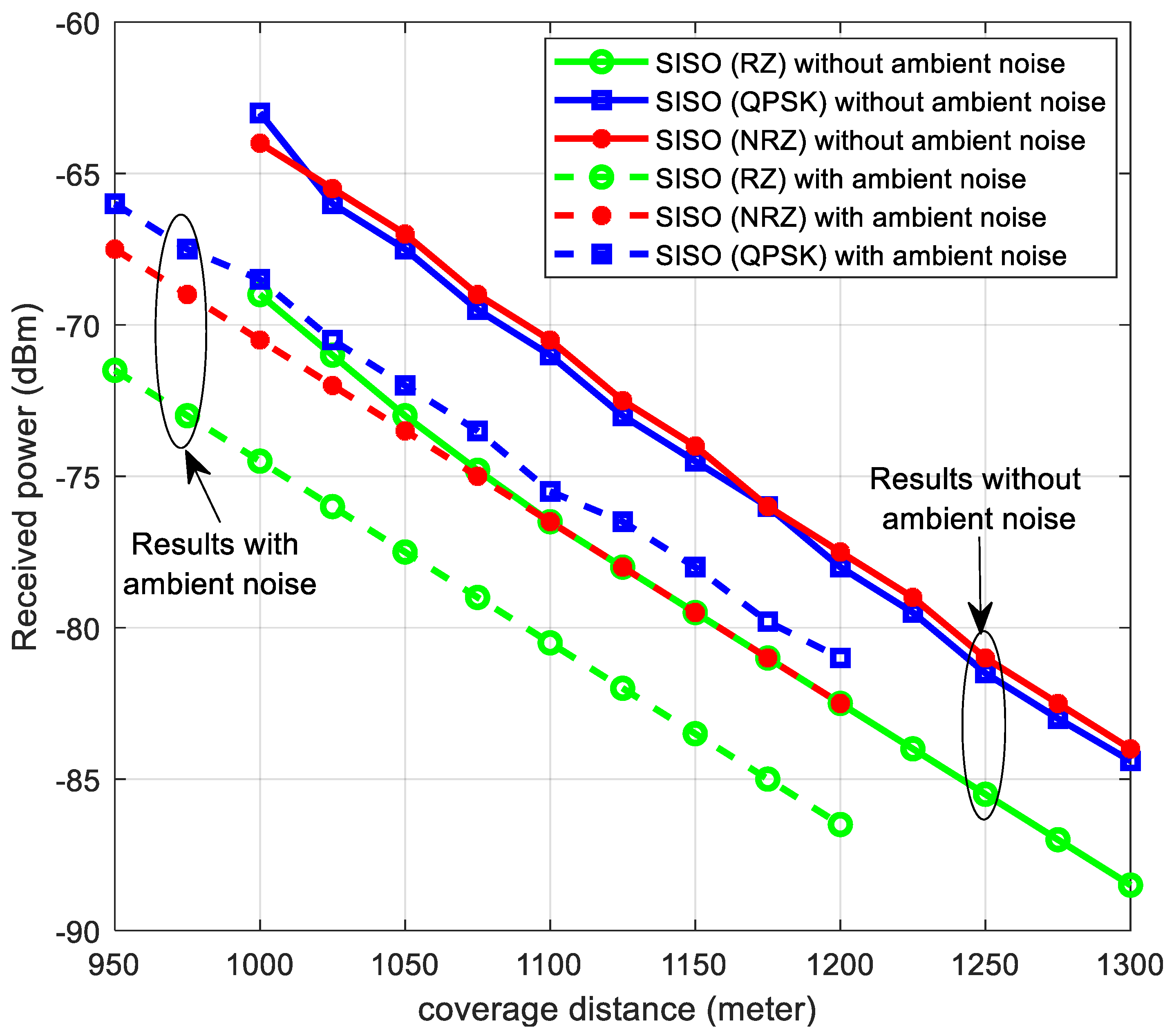

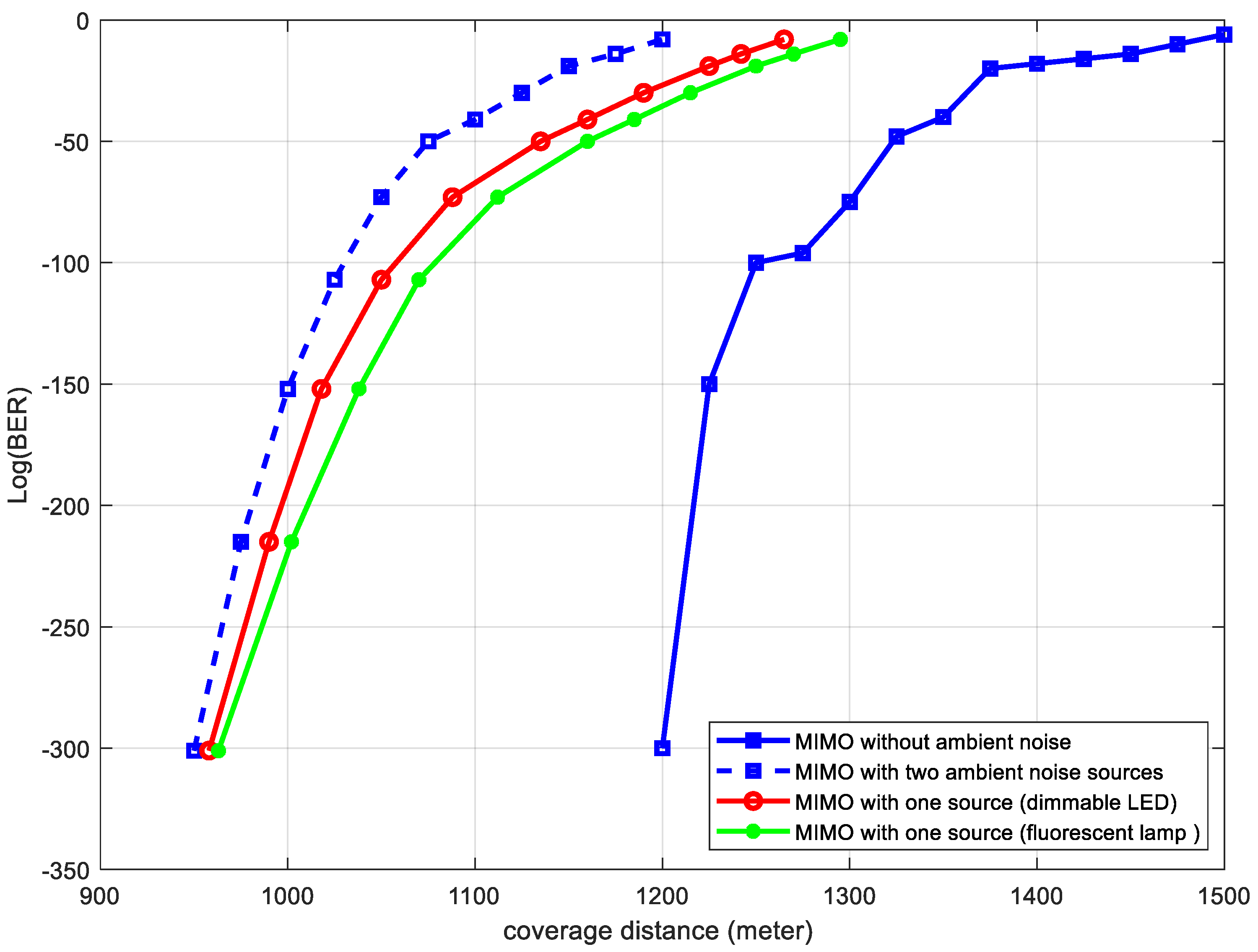

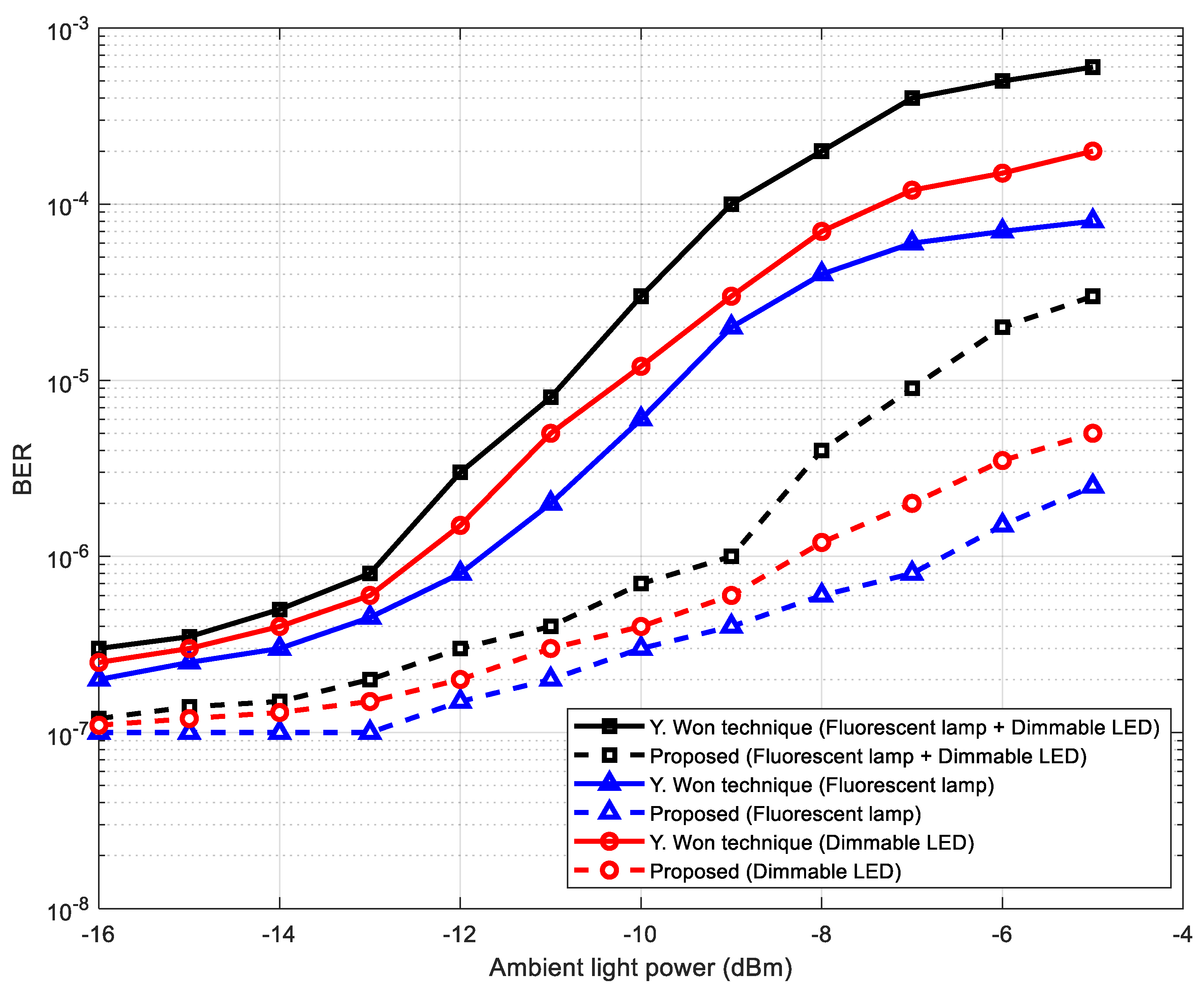
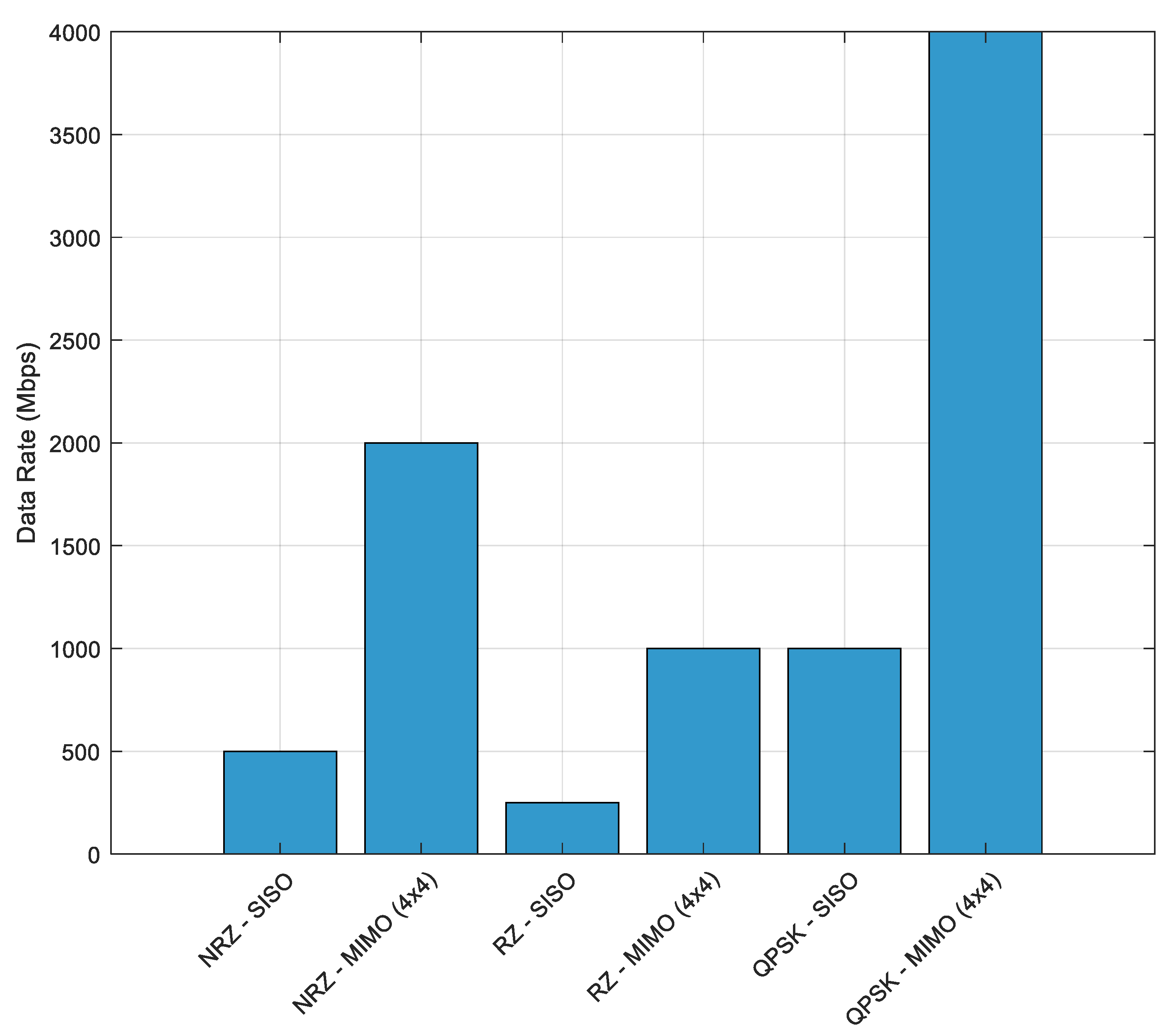
| Ref. No. | Objective | Technologies Used | Performance Metrics | Description | Main Limitations |
|---|---|---|---|---|---|
| [2] | Survey and categorization of MIMO VLC techniques and future research directions. | MIMO VLC, machine learning | BER | Conducted a comprehensive survey of MIMO VLC techniques and discussed the application of machine learning in MIMO VLC systems. Identified future research directions. | Does not address the impact of ambient light interference, which is critical for real-world implementations. |
| [13] | Impact of ambient light on VLC systems. | FPGA and analog circuits for ambient light interference | BER | Investigated the impact of ambient light on VLC systems using an experimental setup with a hybrid structure (FPGA and analog circuits). | Does not explore the use of MIMO technology or analyze different modulation schemes that could enhance performance under varying ambient light conditions. |
| [14] | Effect of traffic density on SNR and BER in V2V-VLC systems. | V2V–VLC | SNR, BER | Examined the effect of vehicular traffic density on SNR and BER in V2V–VLC systems. | Does not consider ambient light interference or the effects of various modulation schemes under different traffic and lighting conditions. |
| [16] | Analysis of MIMO–VLC system performance considering distance, data rate, and modulation techniques. | MIMO–VLC | BER, transmission distance | Assessed MIMO–VLC system performance considering distance, data bit rate, and modulation techniques. | Does not consider ambient light interference or analyze the impact of different modulation schemes on system resilience to such interference. |
| [17] | Comparison of NRZ–OOK and RZ–OOK performance in VLC systems. | OptiSystem simulation, NRZ–OOK, RZ–OOK modulation | Q-factor, BER | Studied the performance of indoor VLC systems using NRZ–OOK and RZ–OOK modulation in OptiSystem, showing improved performance with NRZ-OOK. | Limited focus on NRZ–OOK and RZ–OOK without exploring advanced modulation techniques. Does not investigate the use of MIMO systems. |
| [27] | Evaluation of VLC system performance using white LEDs at different data rates and link lengths. | NRZ–OOK modulation, OptiSystem simulation | Q-factor, BER | Evaluated the performance of an indoor VLC system using white LEDs, measuring quality factor and BER at various data rates and link lengths. | Focuses only on NRZ–OOK modulation and lacks advanced interference mitigation techniques beyond a rectangular optical filter. |
| [28] | Mitigation of ambient light interference in vehicular VLC systems. | Various suppression methods in electronic and optical domains | BER | Investigated techniques to suppress ambient light interference across multiple domains, focusing on VLC systems for vehicular communication. | Does not analyze the effects of modulation schemes or MIMO techniques, and is limited to specific methods of interference suppression. |
| [29] | Vehicular VLC network architecture for I2V and V2V communication. | Tree-based network access scheme, VLC | Network coverage, connectivity | Proposed a vehicular VLC network architecture for I2V and V2V communication using a tree-based access scheme to enhance coverage and connectivity. | Does not explore the effects of modulation schemes or MIMO techniques. |
| [30] | VLC-based aeronautical network for in-flight entertainment distribution. | WDM, DS-OCDMA, 2D-OCDMA, FSO | BER | Proposed an aeronautical VLC network architecture for in-flight entertainment distribution using advanced wavelength assignment techniques. | Does not provide in-depth exploration of modulation schemes or MIMO techniques and focuses primarily on optical interference mitigation. |
| This work | Evaluation of MIMO–VLC systems under ambient light interference and varying transmission distances using different modulations. | MIMO–VLC, NRZ, RZ, QPSK modulation | BER, transmission distance, system resilience | Evaluates MIMO–VLC systems using various modulation techniques, focusing on performance under ambient light interference and varying transmission distances. | Addresses gaps in prior studies by analyzing the combined impact of MIMO, modulation schemes, and ambient light interference. |
| Parameters | Value |
|---|---|
| Data rate | 1 Gbps |
| Power of LASER | (10–30) dBm |
| Wavelength of LASER | 700 nm |
| Frequency of LASER | 428 THz |
| Channel attenuation | 25 dB/km |
| Optical amplifier gain | 20 dB |
| Optical amplifier noise figure | 4 dB |
| Wavelength of ambient noise | 550 nm |
| Cutoff freq. of low-pass Bessel filter | 0.75 × data rate |
| Communication distance | Up to 1.35 Km |
| Receiver field of view (FOV) | ±60° |
| Photodetector responsivity R | 0.6 A/W |
| Line Coding | Achievable Link Distance in Meter | |
|---|---|---|
| SISO | MIMO | |
| NRZ | >1250 | ~1450 |
| QPSK | >1250 | ~1425 |
| RZ | <1250 | ~1425 |
| Line Coding | Achievable Link Distance in Meter | |
|---|---|---|
| SISO | MIMO | |
| NRZ | ~1150 | ~1250 |
| QPSK | ~1125 | ~1225 |
| RZ | ~1150 | ~1250 |
Disclaimer/Publisher’s Note: The statements, opinions and data contained in all publications are solely those of the individual author(s) and contributor(s) and not of MDPI and/or the editor(s). MDPI and/or the editor(s) disclaim responsibility for any injury to people or property resulting from any ideas, methods, instructions or products referred to in the content. |
© 2025 by the authors. Licensee MDPI, Basel, Switzerland. This article is an open access article distributed under the terms and conditions of the Creative Commons Attribution (CC BY) license (https://creativecommons.org/licenses/by/4.0/).
Share and Cite
Hassan, E.S.; Jabbari, A.; Alharbi, A.A. Evaluating MIMO-VLC System Performance: Modulation Techniques and Ambient Light Interference Effects. Photonics 2025, 12, 649. https://doi.org/10.3390/photonics12070649
Hassan ES, Jabbari A, Alharbi AA. Evaluating MIMO-VLC System Performance: Modulation Techniques and Ambient Light Interference Effects. Photonics. 2025; 12(7):649. https://doi.org/10.3390/photonics12070649
Chicago/Turabian StyleHassan, Emad S., Abdoh Jabbari, and Ayman A. Alharbi. 2025. "Evaluating MIMO-VLC System Performance: Modulation Techniques and Ambient Light Interference Effects" Photonics 12, no. 7: 649. https://doi.org/10.3390/photonics12070649
APA StyleHassan, E. S., Jabbari, A., & Alharbi, A. A. (2025). Evaluating MIMO-VLC System Performance: Modulation Techniques and Ambient Light Interference Effects. Photonics, 12(7), 649. https://doi.org/10.3390/photonics12070649






